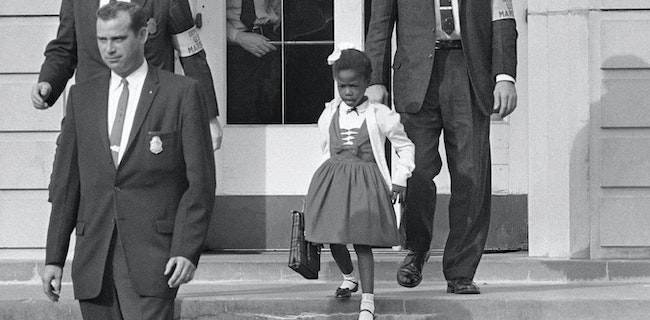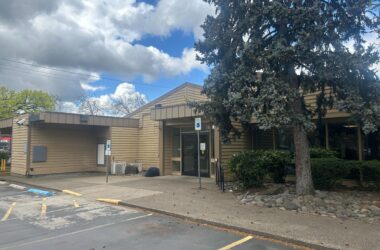 Six-year-old Ruby Bridges and marshals leaving William Frantz Elementary School, New Orleans, on Nov. 14, 1960. She was escorted both to and from the school while segregationist protests continued. Last week, Bridges spoke to an audience hosted by United Way on racial justice in the past, present and future. AP File photo
Six-year-old Ruby Bridges and marshals leaving William Frantz Elementary School, New Orleans, on Nov. 14, 1960. She was escorted both to and from the school while segregationist protests continued. Last week, Bridges spoke to an audience hosted by United Way on racial justice in the past, present and future. AP File photo
At 6 years old, Ruby Bridges unknowingly became a critical figure in the Civil Rights Movement.
It was so surreal, so seldomly spoken about, that for years, she questioned whether or not it even happened.
“I did not realize the impact for a very long time,” Bridges said during a virtual conversation hosted by United Way of Lane County last week. “It wasn’t like people in my community really wanted to talk about it … it was swept under the rug. And because it was a sore subject even for my parents, they didn’t talk about it a whole lot. I remember thinking, ‘Did I dream this?’”
It was no dream.
The reality of her childhood wasn’t self-actualized until Bridges was 17 years old, after an out-of-town reporter came knocking. The reporter showed Bridges a replica of the 1964 Norman Rockwell oil painting, “The Problem We All Live With.”
 Until her teens, Ruby Bridges had no idea she was the subject of this iconic Norman Rockwell painting, “A Problem We All Live With.”
Until her teens, Ruby Bridges had no idea she was the subject of this iconic Norman Rockwell painting, “A Problem We All Live With.”
She had no idea the painting existed. There she was, depicted walking tall in her little dress, bow in hair, being escorted by four tall white men in suits with clenched fists. In the background, the remnants of smeared tomatoes cling to the walls and a racial slur in spray paint drips just above her head.
There she was, little Ruby Bridges, depicted as she makes her way into an all-white elementary school.
It was only then when her memories were validated. It was only then that she began to understand the impact of her early school days, that she was in fact, living history.
“When I saw (the painting) it helped me to understand that this wasn’t something that just happened on my street or in my community, that it was a part of a much bigger movement,” Bridges said.
Much bigger.
She didn’t know it at the time, but Bridges took the first steps in desegregating her New Orleans elementary school. Decades later, she continues her advocacy, expanding it all the way to Lane County.
Last week, nearly 500 people tuned in virtually to a community conversation with Bridges, as she helped United Way launch a Racial Justice Fund, one that, with enough support, will aid local initiatives in addressing racial disparities and advancing equity throughout the county.
***
“Not knowing anything about the Civil Rights Movement, or what was happening in the country during that time,” dressed to the nines in a pink bouffant dress, Bridges was eager to attend her first day of first grade at her new school on Nov. 14, 1960.
She spent kindergarten in a different school, a segregated classroom much farther away than her new school. In 1945, the U.S. Supreme Court’s ruling in Brown v. the Board of Education ended racial segregation in public schools; however, southern states resisted until 1960, when a federal court ordered Louisiana schools to desegregate.
Bridges’ parents were poor sharecroppers who were never granted “the luxury of education.” So when their daughter passed a test granting her attendance to a much better – now integrated – school in New Orleans, it was an opportunity they could not pass up.
But it didn’t come without a cost.
“I remember taking the test,” Bridges recalls. “It was supposedly set up to make sure that kids of color were ‘smart enough’ to go into these white schools – at least that’s what we were told. But indeed the test was set up to eliminate kids … it was made so hard to make sure that we would not pass.”
Of the 150, only six passed, and Bridges was one of them.
As she readied for her first day of school, she recalls federal marshals knocking on her front door, who were sent by President Dwight D. Eisenhower to escort her to the all-white William Frantz Elementary School. She was the first and only Black child to attend that school that day.
As the vehicle turned the corner toward the school, Bridges remembers a large crowd gathering. Through a child’s eyes, she was unafraid. She thought it might be a Mardi Gras celebration underway, something she was accustomed to seeing in her town.
It wasn’t.
It was a crowd of over 200 in full protest of desegregation, carrying signs, screaming racial slurs and death threats as she made her way out of the vehicle. A Black babydoll in a casket circulated the crowd as she and the four marshals hurried inside to the principal’s office, where she sat with her mother all day.
The crowd followed Bridges into the school. As they passed the principal’s office, people stopped at the window, pointing and shouting at Bridges. She still remembers the angered looks on their faces.
The next time the crowd passed her window, they had their kids with them.
“There I was sitting in the office, watching that unfold, not knowing what was happening,” Bridges said. “Over 500 kids walked out of school that day because the parents did not want them attending school with a Black child.”
The crowds were even larger outside the next day, and inside, the school a ghost town.
“I can still distinctly remember hearing our footsteps because the building was so empty,” when she walked through the halls, she said.
But this time, she was warmly greeted by a new teacher, Mrs. Barbara Henry.
“My first thought was that she was white. I’d never seen a white teacher before … And she looked exactly like the people outside. I was not sure how to accept her,” Bridges said. “She did not seem angry like the people outside, but she definitely looked like them.”
It didn’t take Bridges long to realize that her new teacher was nothing like the people protesting outside.
“She showed me her heart. She was an amazing teacher who was accustomed to teaching diverse groups of kids and did not care what I looked like,” Bridges said.
She taught Bridges the lesson that she’s carried with her ever since: “You have to allow yourself an opportunity to get to know someone and judge them by their heart. It’s what I did with Mrs. Henry and that shaped me into who I am today.”
Decades later, Bridges still carries the lessons learned by Mrs. Henry, and has continued her advocacy for racial justice. Her hope is that young people will gravitate toward her message, and that they understand that they, too, can make a difference.
 Ruby Bridges, speaking from her home to help United Way of Lane County launch a Racial Justice Fund to help address racial disparities and advancing equity throughout the county. ERIN TIERNEY/CHRONICLE PHOTO
Ruby Bridges, speaking from her home to help United Way of Lane County launch a Racial Justice Fund to help address racial disparities and advancing equity throughout the county. ERIN TIERNEY/CHRONICLE PHOTO
“Racism really is a grown-up disease,” she said. “None of our babies come into the world knowing anything about disliking one another. We have taken racism and we have passed it on. That is why it is still around today, and that is why we see what we see playing out before us today. We are responsible for it, not our kids.”
***
As United Way of Lane County celebrates its 75th anniversary, it kicks off its own Racial Justice Fund, which will be used to help build “power, influence, access and wealth” to local communities of color, said community advocate Mo Young, who will chair the new fund.
“We know that injustice and disparity is not new in our communities,” said Kori Rodley, chief experience officer for the United Way Lane County. “It is long past time we rolled up our sleeves to not only invest intentionally in initiatives led by and serving communities of color, but to also welcome leadership and inclusion to make sure resources are going to tackle those challenges identified by those most impacted.”
So far, $40,000 has been raised, with the intent to build up the fund as much as possible for the first grant distribution in 2022 to create a sustainable and lasting fund, Rodley said.
In the next four months, the task force will host a series of listening sessions and one-on-one conversations with members of communities of color, asking them about what challenges are most pressing, what outcomes they expect to see, and what people, organizations and initiatives should be considered for funding.
The goal is to distribute the first rounds of investments to grantees in July 2022.
“We cannot create a community where every child succeeds without recognizing and addressing historic and present-day injustice … and the way systemic racism hinders our community’s ability to succeed,” Young said.
Historic and present-day injustice, as pointed out by Young, traces back to when white settlers came to what is now Lane County and took land from indigenous communities. It was justified as the “encroachment of a superior race upon an inferior race,” as reported on page 159 of “The Illustrated History of Lane County, Oregon” by Albert G. Walling.
In recent history, on Aug. 24, 1949, Lane County’s first Black neighborhood was bulldozed over, as documented in Lane County public records.
In present day, Lane County law enforcement agencies reported a 28.6% increase in bias crimes in 2020, and that Eugene leads Oregon in reported bias and hate crimes, according to data released by the Federal Bureau of Investigation.
We’ve got a long way to go, and “we’re not going to get where we want to get to separately,” Bridges said. “We’re going to need the support and help of each other to get where we want to be, to share equal rights, to raise the kinds of young people that we can all be proud of. That’s not going to happen separately and apart. It may happen for a few of us, but it’s not gonna happen for all of us, until we do it collectively.”
To learn more, and to donate, visit unitedwaylane.org.







